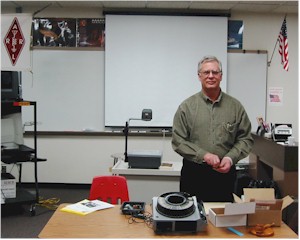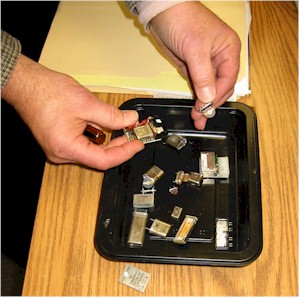

United We
Stand 
|
|
|
United We
Stand |
|
Brainerd Area Amateur Radio Club |
|
Club Meeting March 28, 2002 |
The Brainerd Area Amateur Radio Club met on Thursday, March 28th at 7 PM for a monthly business meeting.
|
Draft Repeater Report: Perceived
problems with current repeater system Current
system utilization Desirements Funding Labor Recommendations: |
 |
At 8:15 PM, Roger Williams WØWUG
explained oscillator crystals, how they are manufactured, and how they are
used. This was a good informative presentation by someone who knows
the subject well.
|
| The
presenter, Roger Williams, WØWUG,
wishes to thank everyone for their hospitality, and kind comments after
the club meeting.
Don’t:
At
the beginning of the program Thursday, I mentioned we were going to discuss alternating current, physics, and
music. Well, we got to two of the three subtopics in the allotted time. It
is a fact in science (physics) that wave motion, and wave generation
follows the same rules and principles whether the waves are on a lake,
sound waves produced by a vibrating string (guitar, piano,violin) , or
high frequency alternating current waves produced by an oscillator circuit
employing a quartz crystal. The
music reference was in regard to the phenomenon of a vibrating mass like a stringed instrument, a vibrating reed
in a wind instrument, or quartz crystal. Physical characteristics of these
devices produce
varying levels of multiple output signals contained in the harmonics and
overtones of the output sound or wave. What
this means is that different instruments playing the exact same note sound
uniquely different. A trumpet
sounds different than a violin,etc, due to the signal strength of the
harmonics and overtones emitted. Another way of saying this is that what
you hear is not just a single tone but a result of many tones at different
levels. The
same is true with quartz crystals, but we use selectivity (filtering) to
pick out the one signal required by the circuit design, otherwise we would
be transmitting (or receiving) on several frequencies at once!. Definitions
of harmonics and overtones can be found on the last page of the article
reprint handed out at the club meeting so we won’t repeat it here. The
point we are getting to is that some high frequency quartz crystals
above 30 MHz for example, would be impossible to manufacture
because of the extremely thin wafer theoretically required. So
crystal makers are able to
manipulate the crystal shape and curvature such that it physically has the
dimensions of a lower frequency (fundamental)crystal, but “likes” to
operate at a much higher harmonic frequency. This technique can produce
oscillations to about 200MHz. In practical terms, crystals operate best in
the 5MHz to 20MHz frequencies. Some
overtone “orders” can be troublesome however. Due to the phase
relationship ( signal voltage polarities) of all the harmonics (whole
number multiples) being produced at once during oscillation, some of these
combine in ways that are displeasing
to the ear, or relating to quartz crystals, some overtone “orders” can
be troublesome and unstable. I’ve
tried to simplify a lot of “heady” stuff here to aid peoples understanding that
a simple looking device , a quartz wafer in a sealed container is a very
complicated and precision electronic component. |
|
 |
Just some of many oscillator crystals and crystal oscillators shown to the group. |
A fun time was had by all.
![]() Back to the BAARC
History Page
Back to the BAARC
History Page
![]() Back to
2002
Back to
2002
This page was last updated 12/19/2006 Ø